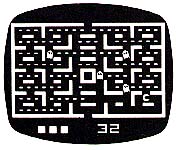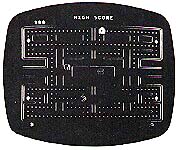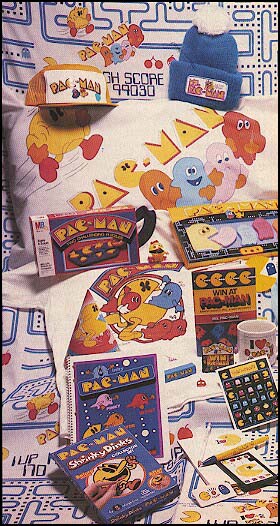
|
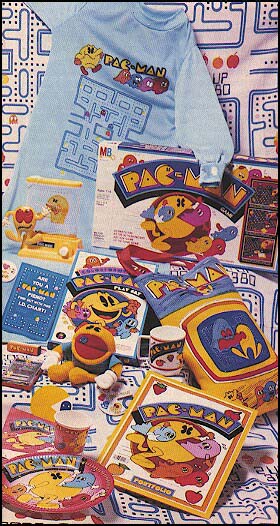
|
PAC-MANIA
By Danny Goodman
It is known as a "hot property."
In the past, it may have been a character or theme from a movie, cartoon or even a comic strip. What makes it "hot" is that people not only pay to experience the original, but long for mementos of the experience, licensed mementos that can bring lots of income to the licensee in sales, and to the licensor in royalties. T-shirts, coffee mugs, bumper stickers, bed sheets. . . they all bear the likeness of the starring character.
But when the star is a video game creature, in addition to the key chains, novelty telephones, and stuffed dolls, you get versions of the game itself that you can bring into your own home.
And so it is with Pac-Man, the arcade game hit of 1981, a game that was still attracting truckloads of quarters well into 1982. A few home video and electronic game makers are hoping those arcade quarters can be converted into dollars--dollars spent on home adaptations of what may be the all-time favorite arcade game.
To check out how well the action, graphics, and sound of the original could be translated to home version, I examined two handheld/tabletop Pac-Man games, plus Atari's cartridges for their VCS, 400/800 home computers, and their new 5200 video game system.
The Tabletop Challenge
Trying to reduce the complexity of detailed arcade screen graphics to a fixed, vacuum fluorescent display in a tabletop game is like trying to reproduce an automobile to a 1/32 scale model. In the model, the windows may not roll down, the dashboard has no working dials or idiot lights, and the motor won't be of the internal combustion or diesel variety. In other words, somethin's gotta give.
And in a tabletop game-where the intent is to draw a parallel to or imitate an arcade original--the major sacrifices are the nuances of the game that give the original its charm in the first place.
Of the two Pac-Man tabletop versions, Coleco's is far and away more arcade-like, compared to Tomy's Pac-Man. The Coleco game is one of the company's mini-arcade series replicas of popular video games.
The screen is partially shaded from surrounding light by a hood--intended to remind us of the semi-enclosed feeling we get when playing full-sized arcade games. Colorful stickers, depicting the cartoon artwork on arcade cabinets, adorn the hood sides and header. Other game characters grace the edges of the screen and the control panel area.
The control's on Pac-Man consist of a simple slide switch (Skill 1, OFF, and Skill 2), plus two, four-direction joysticks. The left stick is your Pac-Man direction controller and Game Select switch. Yes, there are four choices in game selection.
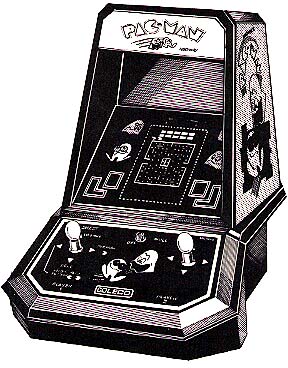
|
| Coleco Pac-Man. |
The first is a self-running demonstration, not particularly useful once you own the game, but surely an eye- and ear-catcher on the store counter. For actual game play, you can choose from: 1) "standard" one player Pac-Man; 2) a rather interesting two-player ("Head-to-Head," in Coleco terminology) PacMan in which you and your opponent vie for the same dots and monsters--the scoreboard shows the points difference between the players and who is ahead; and 3) a novel variation called "Eat & Run" in which the screen shows only the four energizer dots, a monster guarding each, and your Pac-Man. You must snatch one of the energizers and take it back to the central pen when the door opens--of course while all four monsters are on your trail. In many ways, Eat & Run is more fun to play than Pac-Man, and having all three games in one cabinet is quite a deal.
The screen is a fascinating study in packing many distinctly shaped elements into a minuscule plot of display real estate.
By itself, the display yields three colors: red, yellow, and a bluish-green, common to VF calculators. A fourth color, a distinct purplish, is achieved at specific display areas by a color filter bonded to the screen face.
To overcome the problem of portraying so many different characters--Pac-Man, monster, dot/energizer--at a given point, the display designers developed a composite screen character which, when fully illuminated, features the outline of a monster, a Pac-Man with mouth either open or closed, and a dot.
Each element of the composite appears to be addressable such that only a dot or only a Pac-Man can show. Or light up all elements, and you have a monster. Dots and Pac-Men are yellow, while monster outlines and the four energizers are red. Lines composing the maze walls are also red. When Pac-Man eats an energizer, the Pac-Man elements of all four monsters disappear--equivalent to "blue time" on the arcade original--and flash a few times just before the monsters regain their power.
The screen layout is a grid, nine of these composite characters high and eight wide. Above the grid are two rows of status indicators, including number of Pac-Man "lives" left in the game, and "GAME OVER" sign, arrows pointing left and right (to show who is ahead in Head-to-Head play), and the word "BEST" which shines at the end of the game with the score of the highest game of one-player Pac-Man played since the machine was turned on. The five score digits are located at the top of the screen.
I like many of the features of Coleco Pac-Man. For one, the maze layout is about as close to the original as affordable VF technology can get. It is not perfect, by any means, but for the 64 dots/4 energizers on the playfield, the wall layout lets you zoom around corners in smooth patterns as on the original.
Music is another plus. Not only do you get the Pac-Man opening theme when you select a game, but you also get a short rendition of the intermission theme from the original game each time you clear a screen of all dots. And, as on Midway's quarter eater, you get an additional Pac-Man at 10,000 points. This is no easy feat, because, where you may be used to scores in the 6-8000 + range after the first arcade screen, Coleco's scoring system will probably hold you to 2-3000 points.
Yet all is not roses for the Coleco. One major disadvantage of the VF display is that all characters must "step" from location to location. The stutter-stepping movement is difficult to predict, especially when monsters are breathing down your neck. You can't tell which way they are going to move at a corner or intersection, so you unnecessarily lose quite a few Pac-Men.
There is no fruit to go after, either. In the arcade, the chance for a bonus score is a marvelously distracting element.
Next, the noise of the game, a kind of electronic whining, doesn't make the grade in reproducing the original sound. That would be all right, but it is so loud and constant that it drives you nuts after a while. Why don't all tabletop makers take a cue from Entex and offer a mute playing mode?
Finally, what may be a minor point--minor, that is, until you get good at the game--the highest (BEST) score you earn or Skill I will be erased from memory when you try to compare your prowess at the Skill 2 level, because the switch passes through the OFF position to get there. There must be a better way to do that.
The price (under $75) may be a bit steep for some, especially since it is a "dedicated" (non-programmable) game. But my guess is that Coleco's Pac-Man will find its way into many home arcades.
Tomy Pac-Man
A much less true-to-arcade version comes in Tomy's yellow disc-shaped Pac-Man. The cleverness of the game's design, however, stops at the basic shape and color.
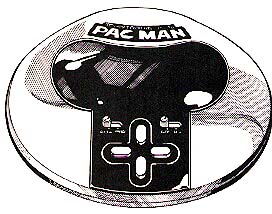
|
| Tomy Pac-Man. |
The vacuum fluorescent display of the unit is simple in concept, with distinct figures for Pac-Man, monsters and dots, in a horizontally- oriented, five-by-eight grid. With each character depicted separately, Pac-Man and a monster never occupy the exact same spot--they can only stand side-by-side in the same grid block. You never know, then, when you are about to be caught by a nearby monster. Nor do you experience that satisfying arcade feeling of having your Pac-Man literally gobble up a monster when he is energized.
Only eighteen dots and two energizers are scattered about the extremely simple maze. Control of Pac-Man is by four directional pushbuttons--an arrangement which has always been awkward for me, whether on a handheld game, or on a micro computer game without joysticks. The most bizarre aspect of this limited reproduction game is that Pac-Man can eat dots only when he is travelling from right to left. I suspect this was thrown in to compensate for the sparse maze.
One redeeming feature of the Tomy game is that the fruit symbol (cherries) appears in a special box twice during each screen. If the game had a more complex maze, this element would add a great deal of excitement, because the opportunity for a bonus makes you take greater risks and breaks up your pattern. But in this maze, you are practically guaranteed of picking the cherries off every time. And, again, Pac-Man doesn't "eat" the cherries. All he does is stand next to the fruit to score 100 points.
One other nice Tomy feature that would have been a blessing on the Coleco is that after the game, the scoreboard toggles between your final score and the screen level you were on. Good players might otherwise forget after a few boards.
For its lack of imitation of the original, however, Tomy's unit has a place in the market with a price of under $35. The sound package may not be as annoying to adults as the Coleco, and the unit may satisfy the youngster demanding some kind of home Pac-Man action.
Video Renditions
Atari raised the expectations of VCS owners when they announced the coming of the only officially licensed Pac-Man video game cartridge. In fact, as one method to keep potential VCS buyers from straying to Brands X, Y or Z at Christmas last year, Atari ran newspaper ads foretelling of the impending arrival of Pac-Man in VCS cartridge form.
In their early 1982 cartridge catalog, Atari stated clearly in it description of the cartridge that Atari's Pac-Man "differs slightly from the original." That, perhaps, was an understatement.
The maze layout is horizontally oriented--a necessity for home TV sets--and has escape hatches at the top and bottom of the screen. It takes only a couple seconds of working Pac-Man through the maze to realize that the maze itself is no piece of cake. There are few long straightaways, and it is not easy to find patterns that allow smooth flow for Pac-Man without having to double back over covered territory to get one last dot in a quadrant.
Other graphic elements roam far from the original. Dots are played by dashes, bonus fruit is played by a yellow and orange box called a vitamin, and the four energizer dots are portrayed by dashes called power pills.
Pac-Man has a different way of opening his mouth in Atari's version--sort of a vertical chew, rather than the customary hinged gobble. Monsters, called ghosts, don't have moving eyes to indicate their direction, and they are all the same color. They do, however, turn a bluish color when Pac-man is energized (power pilled?). The game starts with four Pac-Man lives, and you earn an extra Pac-Man each time you clear the board of dots.
As with most Atari VCS cartridges, this one, too, offers several game variations--eight to be exact. Each variation controls the speed of Pac-Man or ghosts. Game number six is the fastest speed, and probably the one skilled players should go to immediately.
One word of warning: you must anticipate turns early. PacMan is a bit slow to react to the joystick--but he is on the arcade version, too.
|
|||
|
Interest in the Pac-Man cartridge exploded when it first became available in March, 1982. But by early summer, there seemed to be either plenty of cartridges around in the stores, or a diminished interest in the VCS version. I suspect the latter, as word-of-mouth spread that the game was nothing at all like the arcade game.
Much criticism has been hurled at the Atari game designers about Pac-Man. In a way this criticism is unfair. Granted, as a replica of the original arcade board, the VCS cartridge fails miserably. But as a challenging video maze game on its own merit, it would rank high on the list of great cartridges if the arcade game had never existed.
Atari's Pac-Man is not a bad cartridge--just a sad replica of an arcade game. Limited graphics ability of the VCS is partly responsible, but the real problem is that the cartridge is called PacMan with an asterisk: referring to the Midway trademark. Atari seemed to gobble up the video game rights to a very popular game--leading VCS followers to assume Atari would try to imitate the original elements--and therefore keep would-be competitors out of the dot/maze game cartridge arena (Odyssey2 and Astrocade had dot/maze games on the market and in the wings, respectively). Thus the great Pac-Man VCS expectations were shattered.
Computer Pac
Even if the VCS cartridge pulled the rug out from arcade aficionados, Atari's home computer and 5200 advanced video game system cartridges will make them drool. Whereas the VCS game play scarcely resembles its founding father, the more expensive home versions have practically everything covered, and covered well. About the only visible difference between arcade and these home Pac-Man games is the orientation of the video screen. The home TV is irrevocably a horizontally proportioned device, while most arcade screens are vertically oriented.
But everything is faithfully reproduced: the different colors and behaviors of the monsters, skill level symbols at the lower right of the screen (also appearing twice each board for bonus points), scoreboard "1 UP," "2 UP," and "HIGHEST SCORE" at the top. Scoring is identical to the original, including an extra Pac-Man (as shown on the lower left of the screen) at 10,000 points. For trivia fans, these advanced Atari version screens have 256 dots vs. 240 on the arcade.
Sound cues are a bit different. I guess the sound chip inside the computer and the 5200, its close relative, can't recreate my favorite "wocka-wocka-wocka" sound.
Instructions are simple, and they include something most Pac-Man fanatics had to learn from a Pac-Man beater's paperback guidebook: a chart of Pac-Man, Blinky and other monsters' relative speeds at each board level, plus the length of monster blue time and number of transitional flashes before turning aggressive at each level.
As much as I liked the computer cartridge, the 5200 system cartridge won me over with the finishing touch: two intermissions, complete with arcade game music and humorous scenes. I haven't seen the second intermission yet, but I presume it is like the arcade game, and we are spared the third intermission which shows what a disrobed monster looks like.
Both versions offer a feature Pac-Man freaks would certainly like to see on the arcade machine. At the press of a button, you can select the starting point of the game from eight different levels, ranging from Cherries (1st maze) to Keys (13th maze). That way, you can practice higher levels without wading through the slow, easy levels.
What is so amazing about the computer and 5200 versions is that the displays have remarkable graphic detail in a far coarser resolution medium (home color TV) than the arcade screen: Yep, Atari did pull off a superb rendition--actually, two of them--of our lovable Pac-Man and his ordeal. These cartridges certainly earn the right to the asterisked Pac-Man title.
Short of trying to buy up a well-used, reconditioned Pac-Man arcade game for perhaps $1500, you can still get at least two dam good home versions for under $400 and be able to play a bunch of other arcade games besides.
Save up those quarters!
